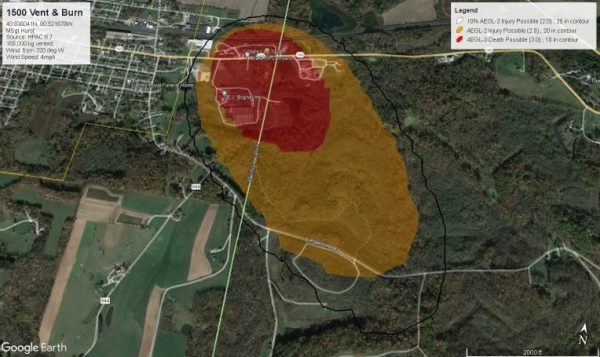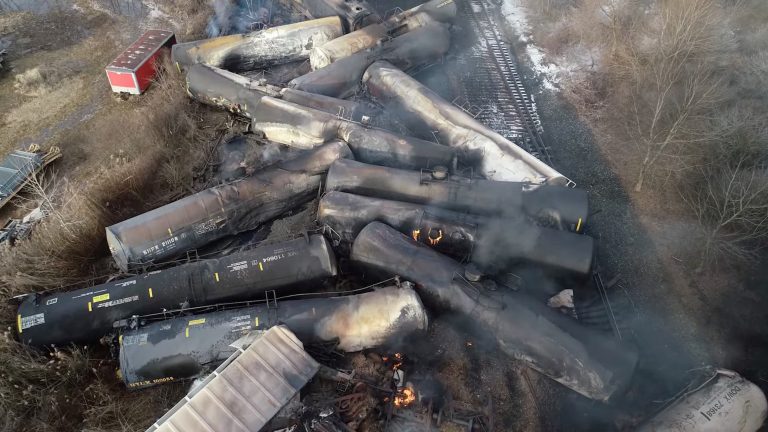Although the federal and state governments have confirmed that the air quality in Ohio and Pennsylvania is well following a massive burn off of a highly toxic chemical spill caused by a train derailment, the true environmental impact of the event still remains unknown.
A 150-car Norfolk Southern Railway train carrying hazardous materials derailed in East Palestine, Ohio, during the night of Feb. 3.
Reporting at the time by Wisconsin NBC affiliate WMTV showed stunning scenes as firefighters battled an enormous blaze at the site described as possessing “flames and plumes of smoke that could be seen for miles.”
WMTV’s reporting stated that Mayor Trent Conaway had told the outlet that while the town’s drinking water was not at risk, local groundwater had already been contaminated.
The outlet stated, based on a report from officials with the National Transportation Safety Board (NTSB), that in total, 50 cars had derailed.
Success
You are now signed up for our newsletter
Success
Check your email to complete sign up
20 of the 50 cars were carrying hazardous materials, and 14 were carrying the carcinogen PVC plastic precursor vinyl chloride.
The outlet also quoted Sil Caggiano, a hazardous materials expert, as stating, “From my experience, Norfolk Southern’s number one goal is to get the rail line open, because they’re losing millions of dollars for every hour that the rail line is shut down, depending on how busy it is.”
‘Controlled release’ of vinyl chloride
An article on the NIH’s National Cancer Institute’s website about vinyl chloride states that the chemical is produced as a combustion product in cigarette smoke, and is associated with both normal and rare liver cancers, brain and lung cancer, leukemia, and lymphoma.
A press conference held by the NTSB on Feb. 4 provided little details to the media, but stated that while a preliminary report on the derailment would be available in 4 to 6 weeks, a full report will take at least 18 to 24 months to be released.
The NTSB stated that the train originated in Madison, Illinois, and was headed for Conway, Pennsylvania before derailing in East Palestine, which shares a border with Pennsylvania.
Emergency crews and response teams were unable to get the situation under control.
On Feb. 6, Ohio Governor Mike Dewine and PA Governor Josh Shapiro ordered a full evacuation of the area in lieu of plans by Norfolk Southern to release the vinyl chloride from the train cars and burn it off into the surrounding environment.
A press release from Gov. DeWine’s office stated, “The vinyl chloride contents of five rail cars are currently unstable and could potentially explode, causing deadly disbursement of shrapnel and toxic fumes.”
“To alleviate the risk of uncontrollable shrapnel from an explosion, Norfolk Southern Railroad is planning a controlled release of the vinyl chloride at approximately 3:30 p.m. today.”
The Governor paraphrased Norfolk Southern as explaining “the controlled release process involves the burning of the rail cars’ chemicals, which will release fumes into the air that can be deadly if inhaled.”

Outlets such as CNN in reporting at the time downplayed the risks from the chemical burn.
One Feb. 6 article described vinyl chloride as a “man-made chemical used to make PVC,” and highlighted the risks as “burns easily at room temperature; can cause dizziness, sleepiness and headaches,” in addition to potential cancer risks.
The article then cited the CDC in apparently claiming that vinyl chloride was relatively harmless, “Vinyl chloride in water or soil evaporates rapidly if it is near the surface. Vinyl chloride in the air breaks down in a few days, resulting in the formation of several other chemicals including hydrochloric acid, formaldehyde, and carbon dioxide.”
Yet the joint press release by governors DeWine and Shapiro were far more serious in their presentation of the dangers, stating, “Based on current weather patterns and the expected flow of the smoke and fumes, anyone who remains in the red affected area is facing grave danger of death.”
“Anyone who remains in the yellow impacted area is at a high risk of severe injury, including skin burns and serious lung damage,” the Release continued, accompanied by a map of the affected areas.
The venting of pressurized vinyl chloride began with a single explosion, as was anticipated, followed by a steady incineration of the remaining cargo, said Sandy Mackey, a spokesperson for the Ohio Emergency Management Agency.
“That controlled release was the one explosion,” she told Reuters by telephone. “It went as planned. It seemed to be a successful incident.”
‘We basically nuked a town with chemicals’
Two days later on Feb. 8, governors DeWine and Shapiro told residents they were safe to return home.
“Air quality samples in the area of the wreckage and in nearby residential neighborhoods have consistently showed readings at points below safety screening levels for contaminants of concern. Based on this information, state and local health officials determined that it is now safe for community members to return to their residences,” a second press release stated.
On Feb. 13, San Francisco media outlet KRON4 reported that the Environmental Protection Agency had told Norfolk Southern that additional chemicals had been discovered in the derailed cars, including:
- Ethylene glycol monobutyl ether
- Ethylhexyl acrylate
- Isobutylene
Caggiano told the outlet, “We basically nuked a town with chemicals so we could get a railroad open.”
“I was surprised when they quickly told the people they can go back home, but then said if they feel like they want their homes tested, they can have them tested. I would’ve far rather they did all the testing,” the expert added.
Caggiano’s statement was in regard to a portion of the governors’ press release, which stated, “Norfolk Southern Railroad has hired an independent contractor to work with local law enforcement, the U.S. EPA, and state officials to take air quality samples and provide results at no charge to residents.”
The EPA released a full manifest of the train cars and their contents on Feb. 13, which showed eight cars were also carrying “malt liquors.”
The same day, Fox News reported that the EPA said, “Air monitoring since the fire went out has not detected any levels of concern in the community that can be attributed to the incident at this time.”
And although the air quality may have improved a week after the burn, the immediate impact on local wildlife and farmers was significant.
One Feb. 7 article by local NBC affiliate WKBN reported that an area woman who kept six chickens at her home 10 miles away from the burn site had lost her animals the same day.
“Amanda Breshears said the smell caused her eyes to water when she went to let her dog out,” the article wrote, adding, “Breshears was going to feed her five hens and rooster Tuesday morning when she discovered them all lifeless, practically in the same position, with no signs of a predator entering their enclosure.”
Breshears told WKBN, “My video camera footage shows my chickens were perfectly fine before they started this burn, and as soon as they started the burn, my chickens slowed down and they died.”
“If it can do this to chickens in one night, imagine what it’s going to do to us in 20 years,” the woman added.
On Feb. 12 a video was posted to TikTok of footage from the Leslie Run waterway in East Palestine, showing a variety of dead fish seen visible from the surface.
WKBN reported on Feb. 7 that not only had the Ohio EPA’s Office of Emergency Response acknowledged the situation in the Leslie Run, but that the outlet was able to visibly confirm the presence of dead fish in both the waterway and the connecting Bull Creek.
Two days later on Feb. 9, WKBN again reported that a local fox rancher had reported that one of his foxes had died, while the rest of his animals were ill.
“Out of nowhere, he just started coughing really hard, just shut down, and he had liquid diarrhea and just went very fast,” the rancher stated of his deceased fox.
WKBN paraphrased the man as adding, “…all of his foxes have been sick and acting differently since the weekend. Some have abnormally puffy faces and are not eating properly. Many are dealing with stomach issues and are acting lethargic.”
A local dog breeder, the Von Schwarz Doberman Kennel, stated on Facebook that they intended to stay away from the property until able to secure independent ground, air, and water testing.
But when the owners returned to the property on Feb. 7 to collect whelping supplies for an upcoming breeding now to be held off-site, they testified that “within 20 minutes we had horrible headaches, runny noses, burning and swollen eyes, pulsations within the eye sockets, itchy throat, and coughing.”
20 miles on a malfunctioning axle
Most tragic is that perhaps the disaster could have been avoided.
Feb. 10 reporting by the Pittsburgh Post-Gazette stated that the 150-car train powered by three locomotives “had traveled at least 20 miles with a malfunctioning axle,” according to surveillance footage obtained in Salem, Ohio, approximately 30 minutes by vehicle away.
Durings its press conference, the NTSB said, “The crew did receive an alarm from a wayside detector shortly before the derailment indicating a mechanical issue,” and that “then an emergency brake application initiated.”
The Post-Gazette explained that at the scene of the Salem, Ohio footage, “…there is an instrument called a hot box detector, which scans the temperature of the passing train axles to ensure they are not overheated. If the device finds a problem, a defect detection alert sounds over the train radio.”
The publication paraphrased a retired Norfolk Southern engineer as explaining that “detecting a defect so hot that it would appear to be on fire would require the crew to stop the train immediately and inspect the problem.”
“Hot box detectors are typically spaced every 10 to 20 miles apart…On this particular track, the next detector after Salem was in East Palestine,” the paraphrasing continued.
“If the train crew heard an alert shortly before braking, it is likely that the warning came from the detector in East Palestine,” the Post-Gazette added.
Feb. 13 reporting by USA Today affiliate The Enquirer said that Norfolk Southern had submitted a remediation plan to the Ohio EPA, which said the company has already “pulled about 180,000 gallons of oil and water from the area,” in addition to sampling sewer, surface, well, and the town’s drinking water and conducting in-home air quality testing.
“From here, the company plans to install an undetermined number of wells to test groundwater and will treat it if necessary. Officials will also sample soil in key areas, including near where the cars filled with vinyl chloride burned,” the article added.
Reuters contributed to this report.
















